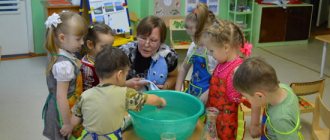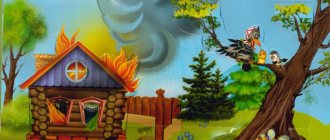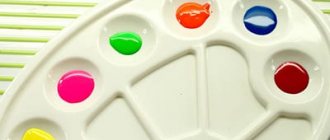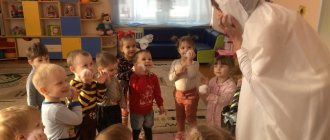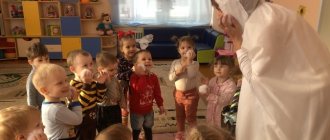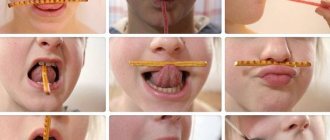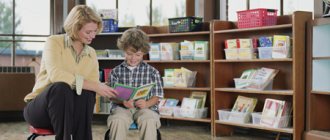Junior group. Early childhood, nursery. Children 1-4 years old
Summary of educational activities on FEMP with children 3–4 years old in the general developmental group “Research and experimentation “Properties”” Purpose: To show children that, in addition to sensory perceived signs, objects have properties that manifest themselves when they interact with each other. Objectives: To consolidate the ability to identify the properties of objects. Develop logical thinking. Activate the dictionary. Cultivate interest...
Summary of educational cognitive and research activities with children 3–4 years old “Magic Snow” MBDOU “Kindergarten”
Sun" Vuktyl 2022
Summary of educational cognitive and research activities with children 3-4 years old "Magic Snow"
Compiled by: Educator of the 1st category: Tumina O.P.
Type of activity : integrated (
cognitive-research , gaming) ...
Exploratory activities on a walk in different seasons
Experience 1:
make a cut with a shovel so that all layers of soil are visible.
♦ How many layers of soil does the ravine have? Which? (Below there are stones, then sand with clay and the top fertile layer of soil.)
Add water.
How does water penetrate soil layers? (The fertile layer of soil easily allows water to pass through; clay and sand do not, because there is no air in the clay.)
What vegetation predominates in the ravine? (Flowers and Curves.)
Experience 2:
consider the top fertile layer of soil.
♦ What is contained in this soil layer? (Rotten matter , their roots, animal remains.)
Guys, to prevent the ravines from getting bigger, people have found a way to strengthen the soil. To do this, you need to plant trees along the slope of the ravine. Their roots are long, penetrate far deep and help keep the soil from being washed away by rain streams. And the clay part of the soil is favorable for tree roots, as it retains moisture longer, and the tree can drink.
Examine through a magnifying glass the branch from which a leaf has just fallen.
♦What did we see? (Barely noticeable buds.)
What does it mean? (The trees did not die, they only shed dead, unnecessary leaves.)
The teacher invites the children to conduct an experiment.
Pour water into a glass jar, close the lid tightly and leave in the cold. Soon the can will split, and instead of it there will be a piece of ice. Frozen water - ice - takes up more space than liquid water, so the ice in the jar became crowded, and it broke it. Ice appears on puddles, rivers, and ponds as soon as the first frost hits. With each frosty day, the ice crust becomes thicker. What happens to ice if it is brought into a warm room? (It will melt.)
What kind of snow can you sculpt from? Try to make a ball of snow.
Compare the freezing time of clean and colored water in large and small molds.
Compare the rate of melting of snow packed tightly or loosely in a glass.
Examine the tracks of birds, compare them with the tracks of a crow. Answer, what is the difference between birds and animals?
Find clouds that look like horses. Compare cirrus and cumulus clouds.
Winter
Research activities
Measure the depth of snow with a snow gauge in different parts of the site.
Determine the condition of the soil in winter.
Catch a flying snowflake on a blank sheet of paper, examine it and determine the properties of snow (snowflake, dust, grain, flakes).
Examine the tracks of birds, compare them with the tracks of a crow. Answer, what is the difference between birds and animals?
Rays of light always travel in a straight line, and if
If any object comes across their path, it casts a dark shadow. Conduct observation - in the morning, at noon, in the evening. (At noon, the sun is directly overhead, the shadow is very short; early in the morning and in the evening the sun drops in the sky, the shadows become long.)
Techniques used
Cognitive and research activities in the younger group are characterized by the presence of various methods and techniques that can significantly simplify the learning process.
The most popular and used in practice are:
- Heuristic method. In this case, the teacher creates a certain problem in order to motivate the child. Thus, it is possible to form a sense of group cohesion in the preschooler in order to find the answer to a particular problem and activate intellectual abilities to analyze the problem. Improving speech, research and inquisitive skills is facilitated by various conversations where the problem is discussed. The teacher must determine the question based on the child’s level of knowledge and also take into account the age of the group. At the same time, the teacher forms clarifying and leading questions in order to lead the preschooler in the right direction. Within the junior group, the duration of such a conversation is from 10 to 15 minutes.
- Observation. Such a process is most often organized within a certain room in a preschool educational institution or on the street, where the perception of various objects or phenomena comprehensively develops the child’s auditory and visual abilities. Those explorations that are carried out during a walk better immerse the preschooler in the world around him due to a greater number of images, smells, colors or sounds.
- Experiments and conducting experiments. Along with the game process, experiments are considered one of the main forms of activity of a preschooler. Thus, when carrying out basic research on objects in kindergarten, the child acquires an important understanding of how they work and begins to see the basic properties and features of objects. Preschoolers with great enthusiasm and pleasure conduct experiments with substances that they already know - clay, sand, plants. Such a research process best creates a desire to conduct independent experiments. This method especially develops concentration, observation, discipline, and also contributes to the development of a friendly atmosphere in the team.
- Project activities . This type of work is aimed at the research activity of preschoolers and teachers, and in some cases, parents. In this case, both the child’s thinking and creative skills are used. The teacher must properly motivate the student to make independent observations and experiments, helping the preschooler only when particularly necessary.
- Technologies using the TRIZ method . It consists of solving electoral tasks, thanks to which the child can independently build algorithms and action plans in order to solve this or that problem. Such a technological solution in kindergarten is often used in a playful way, which allows for more effective interaction with students. The teacher builds fairy-tale plots around learning, which gives the preschooler the opportunity to learn together with their favorite toys or characters from fairy tales and cartoons.
During experiential learning, the child learns the important analysis of information . In this way, a preschooler can learn a new skill by comparing its advantages and disadvantages, and also find more effective teaching methods.
Card index of cognitive and research activities in the first junior group
Terentyeva Galina
Card index of cognitive and research activities in the first junior group
Card index of cognitive and research activities in the first junior group.
Topic: “Why is it inconvenient to play with sand in strong winds” (walk)
Material: “sandbox” - a jar with a thin layer of sand poured into it.
Progress of the experiment: Examination of the prepared “sandbox”. We create a “hurricane” - we sharply squeeze the can with force. - What is happening and why?
Conclusion: The grains of sand are small, light, do not stick to each other, they cannot hold on to each other or to the ground with a strong stream of air.
Theme: “Wet sand takes any desired shape” (walk)
Material: sandbox with wet sand, various molds. Scoops for sand.
Progress of the experiment:
Pour wet sand into molds and make figures. - What kind of figures did you get? — What kind of sand were you able to make the figures from?
Conclusion: Wet sand takes any shape.
Theme “Where did the water disappear” (walk)
Objectives: show children that when water gets on sand, it is quickly absorbed.
Material: cups with sand and water.
Procedure of the experiment: Pour water into a glass of sand. Let's touch the sand. -What did he become? -Where did the water go?
Conclusion: water is quickly absorbed into the sand.
Theme "Soap bubbles"
Goal: to create a desire to blow soap bubbles, to introduce the fact that when air gets into soapy water, a bubble forms.
Material: soapy water, cocktail straws, helium pen body.
Progress of the experiment:
Lather your hands until you get a lush, thick foam. Then separate your palms so that a thin transparent soap film forms between them. Blow on it and you will get a soap bubble. To encourage your child to blow soap bubbles on his own, offer him, in addition to the frame from the purchased bubble, a variety of straws - a cocktail straw. To get a solid straw (kids often bite or bend cocktail straws), you can disassemble the helium pen and take the body from it. You can make your own bubble water using dishwashing liquid.
Experimental game “Which will last longer?” (walk)
Objectives: Show children that air is easy to detect if you create its movement.
Material: Feather, tree leaf, sheet of paper.
Procedure of the experiment: Invite two children to simultaneously blow a feather and a leaf from a tree from their palms. - Why did a feather and a leaf fly in the air? (we blew on him) - What doesn’t fall longer? (a feather, it’s lighter).
Theme "Blowing Soap Bubbles"
Objectives: consolidation of knowledge about air, raising the emotional mood.
Material: Soapy water, cocktail straws, bottles with the bottom cut off, helium pen body.
Procedure: Offer children cocktail straws, bottles with the bottom cut off, the body of a helium pen, and soapy water. During the game, create a friendly attitude towards each other.
Topic: “Why the boats don’t sail”
Objectives: detect air, create wind.
Material: paper and foam boats, bath with water.
Progress of the experimental game: Invite the children to lower the boats into a bath of water, ask if the boats float, why? What needs to be done to make the boats sail? Listen to the children’s suggestions and bring them to the conclusion that wind is needed. Where to “get” the wind? Children blow on boats and create wind.
Theme: “I bake, bake, bake...”
Materials: sand molds, wet sand, cloth napkins.
Progress of the experiment:
Let's try to mold various figures from wet sand using molds. Leave until dry.
— What happens to sand crafts after drying?
Conclusion: You can sculpt from wet sand, but after drying it crumbles.
Topic: “Traces and imprints remain on wet sand”
Objectives: expand children’s understanding of the properties of wet and dry sand.
Material: trays with wet and dry sand.
Procedure of the experiment: Suggest leaving handprints on dry sand. Are the prints clearly visible? (no) The teacher wets the sand, mixes it, levels it, and offers to leave handprints on the wet sand. Is it working now? (Look, every finger is visible)
Conclusion: There are traces and imprints on wet sand, but not on dry sand.
Theme: “Does sand fall easily” (walk)
Objectives: expand knowledge about the properties of dry sand.
Material: trays with sand.
Procedure of the experiment: Suggest that you take a handful of sand into your fist and release it in a small stream. — Does it crumble easily?
Conclusion: dry sand easily crumbles and crumbles into grains of sand.
Topic "What's in the bag?" Experiment (walk)
Goal: Teaching children how to show.
Objectives: Teach children to perform actions as shown by the teacher. Create a feeling of joy and interest.
Procedure: We fill a plastic bag with air and close it. When we open the bag, the air comes out and the bag is empty.
Experimental game “Who will have the longest feather without falling?” (walk)
Objectives: raising the emotional mood, consolidating knowledge about the air.
Material: Bird feathers.
Procedure of the experiment: Together with the children, place a feather on your palm (the feather flew away). Explain to children that air is easy to detect if you create its movement (that is, when we blow on a feather).
Theme "Pebbles"
Objectives: to form children’s ideas about the properties of stones: heavy, strong, hard; at the request of an adult, choose stones by size, color, smoothness, etc.
Materials: Foam sponges, stones of different sizes, colors, smoothness.
Procedure of the experiment: Invite children to press on a sponge, a stone (the sponge is pressed, the stone is not), try with the children to squeeze the stone, the sponge (the stone is not compressed, the sponge is yes, determine the weight in the palm of your hand, the stone is heavy. Invite the children to choose stones of different colors , shapes, surfaces.
Conclusion: the stone is hard, strong, heavy. It comes in different colors, shapes, surfaces (smooth, rough).
D/i “Find identical pebbles by size, color, smoothness” (walk)
Tasks: we continue to consolidate the properties of stones.
Material: pebbles of different shapes, smoothness, and sizes.
How to play: Invite children to find identical pebbles in size, color, smoothness. Place them in separate boxes.
D/i “Collect pebbles” (walk)
Task: throw pebbles into a bowl of water and take them out.
Materials: Various pebbles, a bowl of water, paper towels.
How to play: Invite children to throw pebbles into the basin.
Theme "Pebbles"
Objective: to introduce children to the fact that objects in water can sink or float on the surface of the water.
Material: a bath of water, small heavy and light objects, pebbles.
Procedure for the experiment: Take several small light objects that can float on the water (for example, a feather, a ball, a paper boat, a thin sliver, and several heavy objects that will lie on the bottom (for example, a pebble, a key, a coin). Fill the basin with water Give the child one of the objects and ask him to put it in the water. At the same time, tell him: “Look, the boat floats! But the key sank - it’s heavy! The petal floats - it’s light!” With water and get them out.
D/i “Get a pebble” (walk)
Objective: development of hand motor skills, consolidation of knowledge about the properties of stones.
Materials: Bowl of water, spoon, scoop, paper towels
How to play: Invite children to throw pebbles into a basin of water. Why does the pebble sink? (heavy)
Try to get them out with a spoon or scoop.
D/i “Big and Small” (walk)
Task: put the pebbles into buckets (piles on the table). Consolidating knowledge about the properties of stones.
Material: Pebbles large and small, two buckets.
How to play: Invite the children to put the pebbles into two buckets (one small, the other large). Remember what types of pebbles there are (smooth, rough).
Topic “Snow - snowball” Consideration
tion.
Objectives: To give children an idea of the properties of snow: cold, can mold, melt in warmth, become water
Materials: Basin with snow, cloth napkins.
Progress of the lesson: Pick up snow in a basin and bring it to the group. Children get acquainted with its properties by touching it.
Conclusion: Snow is cold, it can form, melt in warmth, and become water.
Theme “Snow. What is he like? (walk)
Examination.
Objectives: Acquaintance with the properties of snow. Introduce the properties of snow in frosty weather (fluffy, cold, white, moldable, melts in your hands). Develop tactile sensations.
Progress of the lesson: We continue to get acquainted with the properties of snow. Invite the children to take it in their hands and look at it (it is fluffy, white, molds, melts in the hand).
D/i “Different feet stomp along the snowy path” (walk)
Objectives: Teach children to make clear tracks in the snow. Be happy with the result.
Progress of the game: Together with the children, we learn to leave a shoe print. Place your foot carefully without shifting, and lift it carefully (so as not to spoil the mark).
Theme "Beautiful Christmas tree"
Objectives: To form children’s ideas that in the cold, water freezes and turns into ice.
Materials: Water container, paints, ice molds, curly molds, water, strings for loops.
Procedure of the experiment: Dilute water with paint in a container, prepare ice trays, and put strings in them for the loop. Fill with water and refrigerate. Look in the evening (the water has turned into ice).
Conclusion: in the cold, water turns into ice.
Topic: “Making a snowman” (walk)
Objectives: consolidation of knowledge about the properties of snow; snow can be sculpted. Raising the emotional mood.
Progress of the lesson: Remind the children about the properties of snow (white, fluffy, moldable). Invite the children to build a snowman.
D/i “Let’s decorate the Christmas tree” (walk)
Objectives: consolidation of knowledge about the properties of water (transformation into ice). Raising a joyful mood (decorate the Christmas tree with the resulting multi-colored pieces of ice).
Materials: Ready-made frozen colored figures.
Progress of the game: Remember with the children how we made the decorations for the Christmas tree (the water turned into ice). Hang the received toys on the Christmas tree (bush, tree).
Experience "Easy - Hard"
Goal: To introduce children to the weight of objects.
Objectives: Show that objects can be light and heavy. Learn to determine the weight of objects and group them by weight.
Progress of the lesson: Two rag bags. In one there are airy cones (a light bag), and in the other there are pebbles (a heavy bag).
Topic: “Ice slide” (walk)
Objectives: Show children how to make a slide for a doll. To consolidate knowledge about the properties of snow (snow melts well, pour water on it, it freezes and turns into ice).
Topic: “Catch a snowflake” (walk)
Tasks: observing a snowflake, when a snowflake hits your palm, it melts. Consolidating knowledge about the properties of snow.
Materials: Snow shovels, water.
Observation procedure: Invite children to catch a snowflake on a mitten and examine it. What happens to the snowflake? (melts).
Conclusion: The heat melts the snowflake.
Topic: “The wind is blowing, blowing. Games with spinners"
Objectives: introduce children to the concept of “wind”, create wind using breathing.
Materials: Pinwheels according to the number of children.
Procedure of the experiment: Together with the children, pick up the turntables, nothing happens to them. But if you blow on them, the turntables begin to rotate. Why did the turntables start spinning? (we created “wind” with our breath).
Tasks: Observe “Swaying trees on the site” (walk) to give children an idea of the wind: blowing, shaking objects.
Progress of observation: Guys, look at the trees. What's happening to the trees? (they sway) Why? (the wind blows, shaking objects - trees).
Experiment “Games with turntables” (walk)
Objectives: To develop in children the ability to exhale air through the mouth. Introduce children to one of the properties of air - movement (wind). Creating a positive emotional mood.
Materials: turntables according to the number of children.
Progress of the experiment: Teacher: “What is in my basket?” We get the sultanas. We blow (like the wind blows) - they move. If we don’t blow (no wind), they don’t move.
Topic: "Paper" Experiment
Objectives: To introduce children to the properties of paper: it is light (it can be blown away from the palm, it wrinkles, tears, rustles, does not sink in water. To arouse interest in various manipulations with paper.
Materials: Candy wrappers, paper napkins, drawing paper.
Procedure of the experiment: Start rustling paper candy wrappers, attracting children with an interesting sound. Let them try to mash it themselves. Next, show different types of paper (napkin, candy wrapper, for drawing, etc.) and demonstrate what can be done with each of its types.
Experimental game “Snowballs” (walk)
Task: we continue to introduce the properties of paper (crumples). Raising the emotional mood of children.
Materials: Sheets of paper for each child, basket (bucket).
Progress of the experimental game: Together with the children, take sheets of paper and crumple them. What do they look like? (for snowballs). Offer to play with snowballs. D/i “Get into the bucket.”
Breathing exercises “Snowflakes” (walk)
Objectives: training proper breathing; formation of deep exhalation; strengthening facial muscles. We continue to introduce the properties of paper (cutting, making various crafts).
Materials: Snowflakes cut out of paper according to the number of children.
Progress of the exercise:
The teacher hands out snowflakes and recites the poetic text:
To the clearing, to the meadow
A snowball is falling quietly.
And snowflakes are flying,
White fluff
Then he shows the correct execution of the exercise: inhale through your nose, form your lips into a tube and blow on the snowflakes.
